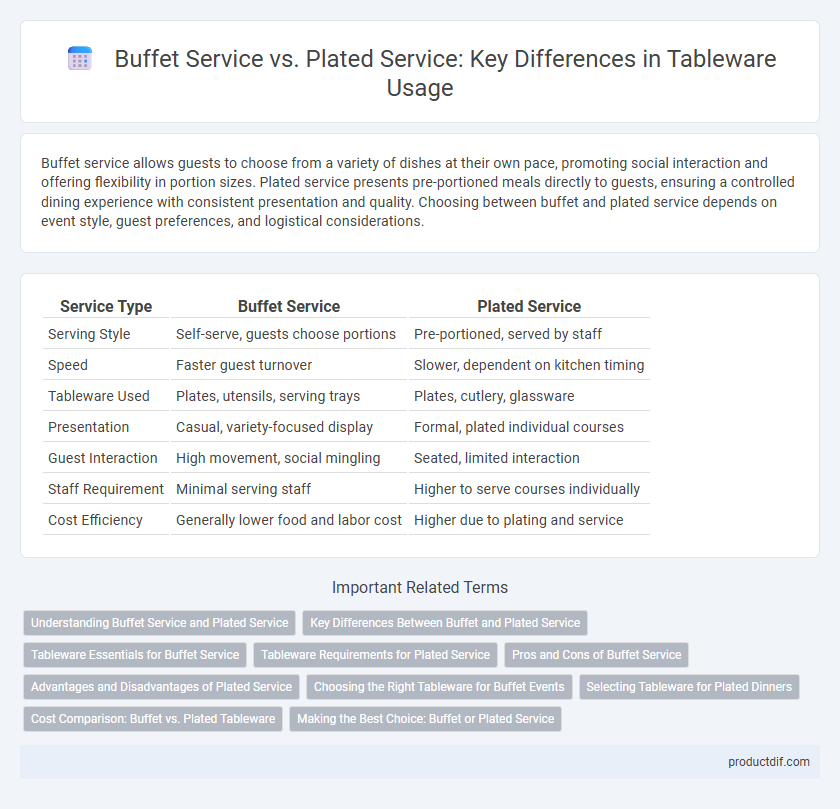Buffet service allows guests to choose from a variety of dishes at their own pace, promoting social interaction and offering flexibility in portion sizes. Plated service presents pre-portioned meals directly to guests, ensuring a controlled dining experience with consistent presentation and quality. Choosing between buffet and plated service depends on event style, guest preferences, and logistical considerations.
Table of Comparison
| Service Type | Buffet Service | Plated Service |
|---|---|---|
| Serving Style | Self-serve, guests choose portions | Pre-portioned, served by staff |
| Speed | Faster guest turnover | Slower, dependent on kitchen timing |
| Tableware Used | Plates, utensils, serving trays | Plates, cutlery, glassware |
| Presentation | Casual, variety-focused display | Formal, plated individual courses |
| Guest Interaction | High movement, social mingling | Seated, limited interaction |
| Staff Requirement | Minimal serving staff | Higher to serve courses individually |
| Cost Efficiency | Generally lower food and labor cost | Higher due to plating and service |
Understanding Buffet Service and Plated Service
Buffet service offers guests the flexibility to choose from a variety of dishes displayed on a table, promoting a casual and interactive dining experience while accommodating large groups efficiently. Plated service involves individually prepared and presented meals served directly to each guest by staff, ensuring portion control and a formal atmosphere ideal for fine dining or special occasions. Understanding these distinctions helps optimize event planning by aligning service style with guest preferences, event scale, and venue logistics.
Key Differences Between Buffet and Plated Service
Buffet service allows guests to serve themselves from a variety of dishes displayed on a table, promoting flexibility and social interaction, whereas plated service involves individually portioned meals served directly to guests at their seats, ensuring precise presentation and portion control. Buffet service is generally more cost-effective and accommodates diverse dietary preferences, while plated service offers a formal dining experience with enhanced attention to detail and service timing. The choice between buffet and plated service impacts event flow, guest experience, and staffing requirements significantly.
Tableware Essentials for Buffet Service
Buffet service requires versatile and durable tableware essentials such as stackable plates, sturdy cutlery, and spill-resistant glasses to facilitate self-service and efficient turnover. Chafing dishes, serving trays, and utensils designed for easy handling and heat retention are critical to maintain food quality and presentation. Napkins and disposable options can also enhance convenience without compromising the dining experience in buffet setups.
Tableware Requirements for Plated Service
Plated service requires precisely coordinated tableware, including charger plates, dinner plates, salad plates, and appropriate cutlery for each course to ensure a seamless dining experience. Fine glassware such as water, wine, and champagne glasses must be strategically placed to complement the meal flow and enhance presentation. The arrangement demands polished flatware and high-quality porcelain or ceramic dishes that uphold the elegance and functionality demanded by formal dining settings.
Pros and Cons of Buffet Service
Buffet service offers guests a wide variety of options and promotes social interaction, allowing individuals to choose their preferred portions and dishes, which reduces food waste. However, it can lead to longer wait times and potential hygiene concerns as many guests handle serving utensils. This style is ideal for casual events with large crowds but less suited for formal dining where presentation and service precision are prioritized.
Advantages and Disadvantages of Plated Service
Plated service offers the advantage of precise portion control and elegant presentation, enhancing the dining experience in formal settings. It allows for efficient service by delivering pre-plated dishes directly to guests, minimizing wait times and reducing the risk of food contamination. However, plated service requires extensive coordination in the kitchen, can limit menu variety, and often results in longer preparation times compared to buffet service.
Choosing the Right Tableware for Buffet Events
Selecting the appropriate tableware for buffet events involves prioritizing durability and ease of handling to accommodate self-service and quick turnover. Opt for lightweight, stackable plates and sturdy flatware with non-slip handles to enhance guest comfort and minimize breakage. Complement these with versatile serving dishes designed for high-volume display that maintain temperature and presentation quality throughout the event.
Selecting Tableware for Plated Dinners
Selecting tableware for plated dinners requires choosing pieces that complement the presentation and enhance the dining experience, such as elegant porcelain plates, polished cutlery sets, and crystal glassware. Plates should be appropriately sized to accommodate multiple courses without overcrowding, while flatware must be arranged to facilitate ease of use during each course. High-quality, durable materials with refined finishes help create a sophisticated ambiance suited for formal plated service events.
Cost Comparison: Buffet vs. Plated Tableware
Buffet tableware often reduces overall costs by minimizing the need for multiple sets of dishes and allowing reusable serving platters, while plated service increases expenses due to individual plate settings and specialized dishware. Buffet setups typically require fewer servers, lowering labor costs, whereas plated service demands precise coordination and higher staffing levels. Choosing buffet over plated service can result in significant savings on both tableware procurement and service logistics.
Making the Best Choice: Buffet or Plated Service
Buffet service offers guests variety and flexibility, ideal for large or informal events where self-service speeds up dining and reduces staff needs. Plated service ensures a refined, personalized dining experience with precise portion control and elegant presentation, perfect for formal occasions or smaller gatherings. Choosing between buffet and plated service depends on event size, atmosphere, guest preferences, and budget considerations to achieve a seamless dining experience.
Buffet Service vs Plated Service Infographic

 productdif.com
productdif.com